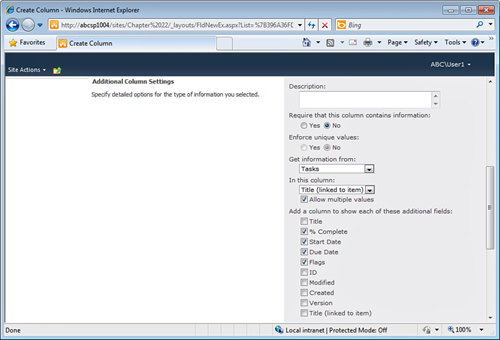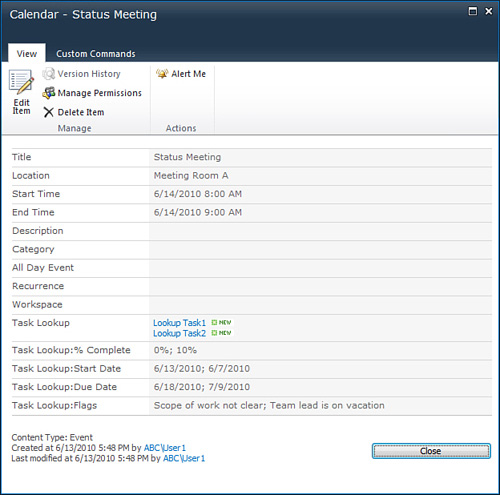Working with Lookup Columns in Document Libraries
This next exercise uses two standard lists in a SharePoint 2010 Team Site: the Calendar list and the Tasks list. The goal of this example is to show the basic capabilities of the lookup column using a business example where a department tracks tasks using a Tasks list, and has weekly meetings that are managed in the Calendar list. The manager wants to use SharePoint to make the meeting more productive and wants to use the lookup column to pull additional information from the Tasks list into the Calendar list.
Consider the possibility that the Tasks list might have different permissions configured than the Calendar list. For example, on this site, the administrator may only allow project managers to edit the Calendar list, whereas all departmental employees can add to the Tasks list.
Before jumping into the example, some information about the functionality and limitations of the lookup column should be provided. To begin with, only certain column types are available to lookup columns. The following list shows the supported column types:
• Single Line of Text
• Date and Time
• Calculated
If other column types exist in the list that is being connected to with the lookup column, they will not be available for selection. This limitation should be kept in mind when planning for the use of lookup columns.
Caution
Exceeding eight lookup columns per list view consumes a large amount of SQL resources, which can result in performance degradation when the view is rendered. Although there can be more than eight lookup columns in the list, make sure to limit the number that are included in specific views.
Follow these steps to learn more about the lookup column’s functionality:
- Create a new site using the Team Site template. Instructions for creating a site are provided in Chapter 21, “Designing and Managing Pages and Sites for Knowledge Workers,” in the section titled “Creating Pages and Sites.”
- Click the link to the Tasks list from the Quick Launch.
- Click the List tab on the Ribbon, and click the Create Column icon.
- Title the column
Flags, and select Single Line of Text as the column type. Leave the other fields on their default values and click OK to save. - From the Tasks list, click Add New Item. Enter the following content in the appropriate fields:
• Title— Enter
Lookup Task 1• Status— Not Started
• % Complete— Enter
0%• Assigned To— Enter a sample username
• Start Date— Enter a sample start date in the future
• End Date— Enter a sample end date that is after the start date
• Flags— Enter
Scope of work not clearLeave the other fields with the default values. Click Save when the data has been entered.
- After again, click Add New Item. Enter the following content in the appropriate fields:
• Title— Enter
Lookup Task 2• % Complete— Enter
10%• Assigned To— Enter a sample username
• Start Date— Enter a sample start date in the past
• End Date— Enter a sample end date in the future
• Flags— Enter
Team lead is on vacationLeave the other fields with the default values. Click Save when the data has been entered.
- The task list should look similar to Figure 22.11.
Figure 22.11. Tasks list with sample tasks to use in a lookup column.

- Now click the link to Calendar from the Quick Launch.
- Click the Calendar tab on the Ribbon, and then click List Settings.
- Scroll down until the link to Create Column appears, and then click Create Column.
- Enter
Task Lookupas the title of the column, and then click Lookup (information already on this site). - Scroll down to the Additional Column Settings section, and click the drop-down menu under Get information From, and select Tasks. The page will update to now show the columns that are valid lookup columns.
- Select Title (linked to item) from the list.
- Check the box next to Allow Multiple Values.
- Then check the boxes next to % Complete, Start Date, Due Date, and Flags. Leave the other values at their defaults, as shown in Figure 22.12, and click OK.
Figure 22.12. Settings for the lookup column in the Calendar list.

- Click Calendar from the breadcrumb trail to return to the Calendar list.
- Click the Events tab, and then click New Event from the Ribbon.
- Enter the following values in the new event:
• Title—
Status Meeting• Location—
Meeting Room A• Start Time—Enter a date and time in the next week
• End Time—Enter a date and time one hour after the start time
• Task Lookup—Click Lookup Task 1 and click the Add button; then click Lookup Task 2, and click the Add button.
Leave the other fields at their defaults and click Save.
- The event will now appear on the calendar on the date specified. Click the name of the event to see the event details, and it should be similar to Figure 22.13. Note that even though only the tasks names were selected, the list item is populated with additional values from the Tasks list: % Complete, Start Date, Due Date, and Flags information is populated. The links to Lookup Task1 and Lookup Task2 can be clicked on from this screen to open the tasks to see additional information.
Figure 22.13. Calendar event with lookup data values.

- Close the Calendar item window by clicking Close.
- From the Calendar, click the Calendar tab, and then click List Settings.
- Locate the Task Lookup:% Complete column, and click it. Change the column name to
Task % Completeand click OK. Note that the name of the column is now changed without breaking the functionality of the column. So, the administrator can make these lookup column titles more user friendly than the default names that are assigned.
An additional option provided in a lookup column is to Enforce Relationship Behavior. While experimenting with this functionality, it is not unusual to see a message display that states “This lookup field cannot enforce a relationship behavior because this list contains incompatible fields.” The following example provides a case where Enforce Relationship Behavior can be tested.
